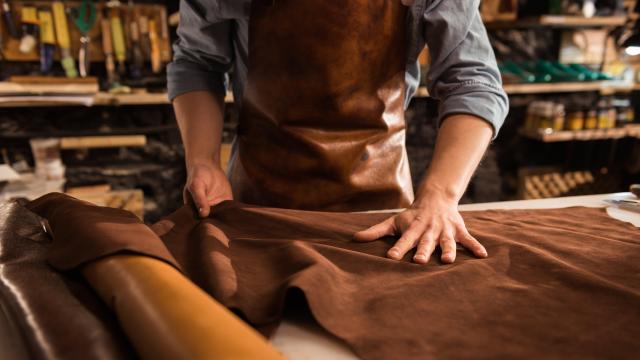When you’re shopping for a leather jackets, shoes, purses, or other items, you may come across a stamped label noting the item is “genuine leather.” If you know nothing about leather grades, you’ll think that’s a good sign. If you know a little bit about leather grades, you’ll think that’s a bad sign. Today, my friends, we dig a bit deeper. It doesn’t necessarily mean either.
“Genuine” is not a grade of leather
There’s a bit of misinformation that keeps getting repeated — that the major grades of leather are top grain, full grain, and “genuine.” Leatherworkers will tell you that’s not really true. Full grain and top grain are terms used within the trade, although the exact definition may vary from supplier to supplier. Genuine leather isn’t a technical term at all.
There are other goods out there sorted by grading systems. Steaks, for example, are graded in the U.S. by the Department of Agriculture as Prime, Choice, or Select. (There are other grades below that, including Standard and Commercial.) There is no comparable grading system for leather.
Leather comes in a dizzying array of types, splits, and finishes. Top grain or full grain leather includes the smooth surface of the skin. To make it thinner, it can be split into layers. That lower layer of skin, fuzzy on both sides, can be sold as suede, but it can also be painted or coated in something like polyurethane to give it a smooth surface that makes it look like top grain or full grain leather.
There is a technical term for this — it’s a “finished split,” and that’s the low-quality leather that people are trying to warn you away from when you’re looking at that “genuine leather” tag. Finished splits can crack when you bend them, or the coating can chip off over time. (Here are some photos here showing what that can look like.)
“Genuine leather” just means it’s…leather
It’s true that a lot of low-quality, split leather products will be labelled “genuine leather.” But that label doesn’t mean that it’s low quality. This blog by North Star Leather explains why. Saying a product is made of genuine leather is like saying a burger is made of real beef, they write. With that in mind, “What kind of place/product gets labelled ‘real beef’? You tend to see that fast food joints feel the need to brag about being ‘real beef’ but you don’t see fancy steakhouses bothering to point it out.”
In other words, “genuine leather” is a term you often see on products where there isn’t anything nice they can say about the leather besides that it is actually leather. In that sense, it can be a sign that the leather is low quality. If a seller can tell you more about where the leather comes from or how it was finished, it won’t usually bear that “genuine leather” label.
But that same blog points out that this is a modern convention. Vintage leather goods were often described as genuine leather, just to set them apart from non-leather products. And sellers in non-English-speaking countries will sometimes feature translated marketing copy that uses the term “genuine leather.” In that case it’s just a language issue; the seller may not know that the term is associated with lower quality leather.
The North Star leatherworker points out that the real problem here is expecting a single term to tell you whether or not an item is worth your money. “Don’t buy because you’re looking for or avoiding a specific keyword,” they write. Find out more about the leather item you’re considering, and pay attention to information like its price and the reputation of the company or craftsperson who made it.

Leave a Reply
You must be logged in to post a comment.